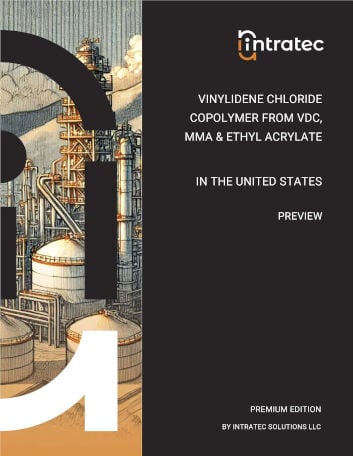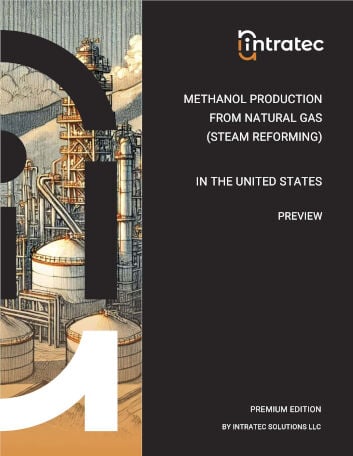Commodity Production Costs Report
Methyl Methacrylate Production from Acetone, NH3 and Natural Gas
Methyl Methacrylate Plant Capital & Operating Cost Analysis | United States | Q3 2025
This report presents the economics of Methyl Methacrylate (MMA) production from acetone, ammonia and natural gas. The process examined is similar to Evonik Aveneer process. In this process, hydrogen cyanide, acetone and methanol are used as raw materials for the production of MMA. Different from the conventional acetone cyanohydrin (ACH) process, this process does not use sulfuric acid. The hydrogen cyanide used is generated from ammonia and natural gas in an on-site unit.
The report provides a comprehensive study of Methyl Methacrylate production and related Methyl Methacrylate production cost, covering three key aspects: a complete description of the Methyl Methacrylate production process examined; an in-depth analysis of the related Methyl Methacrylate plant capital cost (Capex); and an evaluation of the respective Methyl Methacrylate plant operating costs (Opex).
The Methyl Methacrylate production process description includes a block flow diagram (BFD), an overview of the industrial site installations, detailing both the process unit and the necessary infrastructure, process consumption figures and comprehensive process flow diagrams (PFD). The Methyl Methacrylate plant capital cost analysis breaks down the Capex by plant cost (i.e., ISBL, OSBL and Contingency); owner's cost; working capital; and costs incurred during industrial plant commissioning and start-up. The Methyl Methacrylate plant operating costs analysis covers operating expenses, including variable costs like raw materials and utilities, and fixed costs such as maintenance, labor, and depreciation.

The process under analysis comprises three major sections: (1) Hydrogen Cyanide (HCN) Production; (2) 2-hexyl alpha-hydroxyisobutyrate (2-EHHIB) Synthesis; and (3) Methyl Methacrylate (MMA) Production.
Hydrogen Cyanide (HCN) Production. Air, natural gas and fresh and recovered ammonia (NH3) are fed to a reactor, where HCN is produced. The reactor effluent is sent to the NH3 Absorber, which absorbs unreacted ammonia. The absorber's bottom stream is routed to an ammonia redovery section, while its overhead stream is directed to HCN recovery & purification section. Purified HCN is stored in a Surge Tank before being used downstream.
2-EHHIB Synthesis. The HCN from previous section reacts with acetone, yielding acetone cyanohydrin (ACH), which is sent to a hydrolysis reactor to form alpha-hydroxyisobutyramide (HIBA). The hydrolysis product is distilled for the removal of impurities and unreacted components (e.g. acetone) - withdrawn from the top of the column. High-purity HIBA is obtained from the bottom of the column and routed to tubular reactors where it reacts with 2-ethylhexanol (2-EH) yielding 2-EHHIB and NH3. The reactors outlet streams are sent to subsequent distillation columns for 2-EHHIB purification and unreacted components recovery, which are recycled to the reactors. Ammonia obtained from the reaction is separated from unreacted 2-EH and recycled to the HCN synthesis section.
Methyl Methacrylate (MMA) Production. The purified 2-EHHIB is fed to a transesterification section, where it is reacted with methanol to generate methyl alpha-hydroxybutyrate (MHIB) - 2-EH is also generated in this reaction and is recycled to the 2-EHHIB sythesis section. After being separated from 2-EH, the MHIB-rich stream is sent to the cross-transesterification section, where it reacts with methacrylic acid (MAA) to form Methyl Methacrylate (MMA) and 2-hydroxyisobutyric acid (HIBAc). While HIBAc is dehydrated back into MAA to be reused in the process, MMA is sent to a set of distillation columns, from which high-purity MMA product is obtained and methanol is recovered for being recycled to the transesterification section.
Report in PDF Format
Download & Explore Anytime
Access in Various Devices
Print & Read Comfortably
Share With Co-workers
Up-to-date Report
Professional report based on Q3 2025 economic data, ensuring timely evaluations.
Multiple Use Cases
Ideal for investment screening, feasibility studies, cost estimates, and research planning.
Proven Methodology
Developed using a consistent methodology honed over a decade, ensuring reliable cost analyses.
Report Editions
Content Highlights
Plant Capital Cost Summary
Summary outlining the capital cost required for building the Methyl Methacrylate production plant examined.
Plant Capital Cost Details
Detailing of fixed capital (ISBL, OSBL & Owner’s Cost), working capital and additional capital requirements.
Plant Cost Breakdowns
Breakdown of Methyl Methacrylate process unit (ISBL) costs and infrastructure (OSBL) costs; plant cost breakdown per discipline.
Operating Costs Summary
Summary presenting the operating variable costs and the total operating cost of the Methyl Methacrylate production plant studied.
Operating Cost Details
Detailing of utilities costs, operating fixed costs and depreciation.
Plant Capacity Assessment
Comparative analysis of capital investment and operating costs for different Methyl Methacrylate plant capacities.
Production Process Information
Block Flow Diagram, descriptions of process unit (ISBL) and site infrastructure (OSBL).
Process Consumptions
Raw materials and utilities consumption figures, by-products credits, labor requirements
Process Diagrams
Process flow diagrams (PFD), equipment list and industrial site configuration
Other Methyl Methacrylate Production Cost Reports

Methyl Methacrylate Production from Acetone and Hydrogen Cyanide
This report presents the economics of a process similar to Evonik Aveneer for Methyl Methacrylate (MMA) production from acetone and hydrogen cyanide (HCN) in the United States. Initially, HCN purchased from external suppliers, acetone and methanol are used as raw materials for the production of MMA in six main steps, which are described in the report.
Details: 120 kta United States-based plant | Q3 2025 | 107 pages | Issue B | From $1,199 USD

Methyl Methacrylate Production from t-Butanol
This study reviews the economics of a process for Methyl Methacrylate (MMA) production from t-Butanol. Initially, t-butanol is oxidized to metacrolein and then to methacrylic acid. Finally, the methacrylic acid undergoes esterification with methanol to generate MMA. The economic analysis performed is based on a plant constructed in the United States.
Details: 120 kta United States-based plant | Q3 2025 | 107 pages | Issue D | From $1,199 USD

Methyl Methacrylate Production from Methacrylic Acid and Methanol
This report presents the economics of Methyl Methacrylate (MMA) from Methacrylic Acid (MAA) and Methanol. In this process, MMA is produced through the esterification of MAA with methanol. The economic analysis assumes a plant located in the United States.
Details: 200 kta United States-based plant | Q3 2025 | 107 pages | Issue E | From $799 USD
Bundle & Save
Purchase multiple Methyl Methacrylate Production Cost reports and enjoy tiered discounts
up to 30% off!
Could Not Find the Report You Need?
Obtain a Bespoke Report
Get a report targeting the process in which you are interested
See Offer Details
Understand Bespoke Reports and how you can easily order them
Check Editions & Pricing
Complete a brief form and see a quotation for your Bespoke Report
Other Related Production Cost Reports

Methanol Production from Natural Gas (Combined Reforming)
This study presents the economics of large-scale Methanol production from natural gas in the United States. In this process, natural gas is first converted into synthesis gas (syngas) by means of conventional steam reforming and secondary autothermal reforming. Then, the syngas is converted into Methanol.
Details: 1700 kta United States-based plant | Q3 2025 | 107 pages | Issue B | From $799 USD

Ammonia Production from Natural Gas (Combined Reforming)
This report presents the economics of Ammonia production from natural gas in the United States using a process similar to KBR Purifier process. In the process examined, syngas is initially produced from natural gas via a combined reforming. The syngas is purified through several steps into nitrogen and hydrogen which are synthesized to ammonia.
Details: 800 kta United States-based plant | Q3 2025 | 107 pages | Issue B | From $1,199 USD

Vinylidene Chloride Copolymer from VDC, MMA & Ethyl Acrylate
This study presents the economics of Vinylidene Chloride Copolymer production from vinylidene chloride (VDC), ethyl acrylate, and methyl methacrylate (MMA) using an emulsion polymerization process. The economic analysis assumes a plant located in the United States.
Details: 45 kta United States-based plant | Q3 2025 | 107 pages | Issue B | From $799 USD

Acetone Production from Isopropanol
This feasibility study presents the economics of Acetone production from isopropanol using a liquid phase dehydrogenation process. The economic analysis presented in the study assumes a plant located in the United States.
Details: 30 kta United States-based plant | Q3 2025 | 107 pages | Issue B | From $999 USD

2-Ethylhexanol Production from Butyraldehyde
This report presents the economics of 2-Ethylhexanol (2-EH) production from n-butyraldehyde. The process under analysis dehydrates n-butyraldehyde to obtain 2-ethylpropylacrolein, which is then hydrogenated to form the 2-Ethylhexanol. The economic assessment assumes a plant located in the United States.
Details: 160 kta United States-based plant | Q3 2025 | 107 pages | Issue B | From $799 USD

Acetone Production from Propylene (Single-Step Process)
This report approaches the economics of Acetone production from propylene in the United States. In the process examined, a direct propylene oxidation is carried out in the presence of palladium chloride and copper chloride, yielding Acetone.
Details: 80 kta United States-based plant | Q3 2025 | 107 pages | Issue C | From $999 USD

2-Ethylhexanol Production from Propylene and Syngas
This report presents the economics of 2-Ethylhexanol (2-EH) production from propylene and syngas located in the United States. Initially, propylene reacts with syngas in a hydroformylation reaction, yielding n-butyraldehyde. This step uses a conventional OXO-alcohol technology. Then, the n-butyraldehyde is submitted to an aldolization, and is subsequently dehydrated to 2-ethylpropylacrolein (EPA). Finally, the EPA is hydrogenated, yielding 2-EH.
Details: 160 kta United States-based plant | Q3 2025 | 107 pages | Issue A | From $1,199 USD

Methanol Production from Natural Gas (Steam Reforming)
This study presents the economics of large-scale Methanol production from natural gas in the United States. In the process examined, natural gas is first converted into synthesis gas (syngas) by means of conventional steam reforming and then the syngas is converted into Methanol.
Details: 1000 kta United States-based plant | Q3 2025 | 107 pages | Issue A | From $799 USD

Ammonia Production from Syngas
This report presents the economics of Ammonia production from synthesis gas (syngas). In this process, hydrogen, recovered from syngas feedstock, and nitrogen, recovered from air, react producing Ammonia. The economic analysis performed assumes a plant located in the United States.
Details: 800 kta United States-based plant | Q3 2025 | 107 pages | Issue A | From $799 USD
+800 Reports Developed, Targeting +250 Commodities
Vast Report Library
858 independent and up-to-date reports examining embryonic and established production processes.
Free Sample Reports
Quickly understand the structure and depth of content of our professional reports.

